Digital TV: An Easygoing (R)evolution
Digital TV Standards
The merits of digital TV were recognized in the USA very early in the 80's: more TV channels and better image and sound quality. It also allows new possibilities like pay TV, video-on-demand and interactive content. If realized via cable, it also often comes packaged with high-speed Internet access.
The evolution of digital TV in the USA came in conjunction with high-definition TV (HDTV). Introduced for the first time in 1981, it took more than 18 years until the United States Federal Communications Commission (FCC) defined a new standard called ATSC for digital television (DTV). ATSC combines 18 different TV formats, with 6 of them HDTV.
One important factor during the definition process was to make ATSC backward compatible with analog receivers, to prevent the loss of viewers in the transition period from analog to digital. Households will be served with signals in a familiar way, via antenna or cable. ATSC is defined so that the traditional analog NTSC signal is broadcast parallel to the new digital signal. In addition, the FCC committed the large TV networks - ABC, CBS, NBC and Fox - to broadcast at least 80% of their content in digital HD formats, to ensure the success of digital TV and HDTV.
Europe, on the other hand, went its own way and founded the Digital Video Broadcasting project (DVB). DVB has four major digital TV standards: DVB-T (terrestrial antenna), DVB-C (Cable), DVB-S (satellite) and DVB-H (Handheld). Alike ATSC, DVB uses MPEG2 compression for video data and supports Dolby digital AC-3 5.1 surround sound. The next step for DVB-S is DVB-S2, supporting better compression algorithms for HDTV, like MPEG4 or WMV9 for HD content. Future content will also be transmitted via IP multicasting, which uses Internet Protocol (IP) packets to transmit video data or images, websites and audio.
Today DVB standards are widely used in Europe and beyond. The DVB project includes 260 members from 37 countries, including Japan, Canada and the USA. There's a rat-race between ATSC and DVB going on today in many countries, with a lot of politics involved.
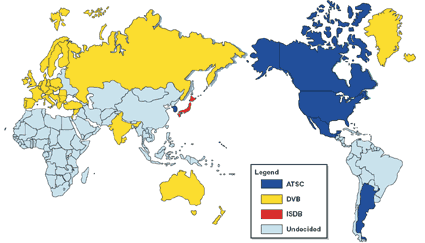
Terrestrial DTV Standards Around the World, July 2004 - By ATSC Forum (click to enlarge)
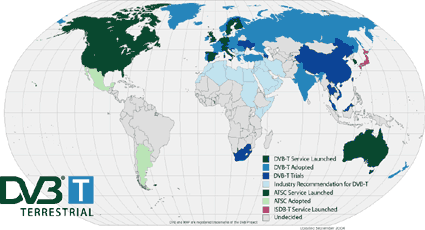
Terrestrial DTV Standards Around the World - By DVB (click to enlarge)
Stay on the Cutting Edge
Join the experts who read Tom's Hardware for the inside track on enthusiast PC tech news — and have for over 25 years. We'll send breaking news and in-depth reviews of CPUs, GPUs, AI, maker hardware and more straight to your inbox.
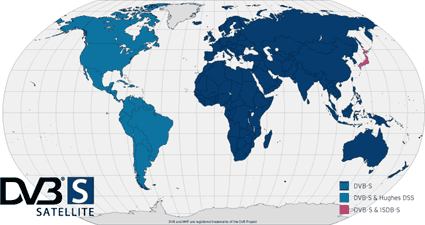
Satellite DTV Standards Around the World - By DVB (click to enlarge)
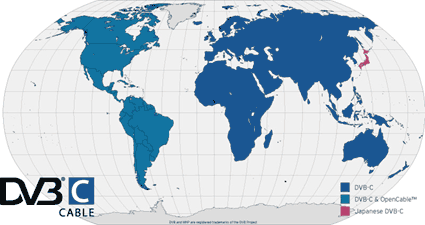
Cable DTV Standards Around the World - By DVB (click to enlarge)
With respect to digital TV, there are several standards being used in the US. The satellite broadcaster DirecTV is banking on the Digital Broadcast System (DBS) developed by Thomson. Others, like Echostar and Alphastar, go with DVB-S. Digital cable broadcasters in the US go with OpenCable (based on ATSC) or DVB-C.
The United States made an earnest entry into the digital satellite-broadcasting era in June 1994 when DirecTV and USSB began offering satellite services with 150 and 25 channels respectively. Although the cable TV industry is spreading its digital roots in US soil, the satellite broadcast operators have already one-upped the cable broadcasters by offering high definition programs with as many channels, grabbing 57% of the digital broadcasting market. North America is currently the world's leading market for digital TV set-top boxes, accounting for more than half of sales. Strategy Analytics predicts that annual sales in this region will almost double over the next five years, reaching nearly 36 million units by 2008.
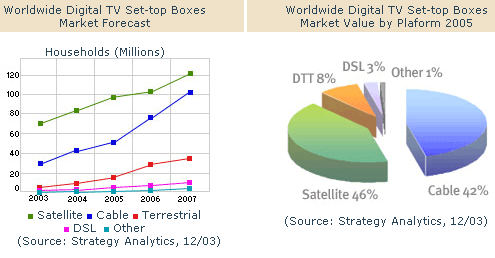
Numbers published by Humax, developer of digital set-top boxes.
Current page: Digital TV Standards
Prev Page TV Markets In USA And Europe Next Page High Definition TV - HDTVMost Popular

